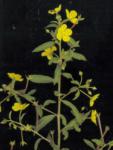Latin name
Ludwigia octovalvis (Jacq.) P.H. Raven
Family
Onagraceae
Common name(s)
Water primrose, primrose-willow
Synonym(s)
Jussiaea angustifolia Lam., J. octovalvis (Jacq.) Sw., J. macropoda C. Presl, J. octonervia Lam., J. suffruticosa L., Oenothera octovalvis Jacq. (basionym), Ludwigia pubescens (L.) H. Hara
Geographical distribution
Asia: Japan.
South and Southeast Asia: Bangladesh, Cambodia, India, Indonesia, Lao PDR, Myanmar, Nepal, Malaysia, Philippines, Sri Lanka, Thailand, and Vietnam.
Rest of the world: Australia, Belize, Brazil, Cameroon, Costa Rica, Cuba, Dominican Republic, Fiji, Guatemala, Honduras, Madagascar, Mauritius, Mexico, New Caledonia, Nicaragua, Nigeria, Panama, Papua New Guinea, Peru, Samoa, Suriname, Tanzania, Trinidad, United States (including Hawaii), and Venezuela.
Morphology
An erect, much-branched, robust perennial herb up to 150—cm—high.
Stem: erect, hairless, sparsely or densely hairy, sometimes woody at base, red-brown and lignified at base.
Leaf: simple, arranged alternately along the stem; blade lance-shaped to ovate, 2.5—15—cm—long, light green and may turn red as plants age.
Inflorescence: flower solitary, axillary, without stalk; petals 4, yellow, broadly ovate or wedge-shaped, 1—1.5—cm—long.
Fruit: green or purplish at maturity capsule, cylindrical to somewhat club-shaped; 3—5—cm—long and 2—8—mm—wide with 8 ribs; fruits contain several rows of seeds.
Seed: brown, rounded, beaked, and about 0.7—mm in diameter.
Biology and ecology
Adapted to a wide range of environments, including wet places, marshes, fresh-water lakes, streams, ditch banks, along railroads, on gravelly riverbeds, flood banks, paddy rice, and flooded grasslands.
Propagates by seeds and a single plant can produce as many as 375,000 seeds; flowers year-round.
Agricultural importance
A widespread and sometimes serious weed of rice in many parts of Asia, Latin America, and the Caribbean, and also in vegetables, maize, irrigated crops, and pastures.
Management
Cultural control: hand weeding is effective.
Chemical control: postemergence application of 2,4-D and MCPA in rice.
Selected references
Henty EE, Pritchard GH. 1975. Weeds of New Guinea and their control. Papua New Guinea: Division of Botany, Department of Forests. 180 p.Hirano RT. 1983. Handbook of Hawaiian weeds. In: Haselwood EL, Motter GG, editors. Honolulu, Hawaii (USA): University of Hawaii Press. 491 p.Holm L, Doll J, Holm E, Pancho J, Herberger J. 1997. World weeds. John Wiley & Sons, Inc. 1,129 p.Moody K. 1989. Weeds reported in rice in South and Southeast Asia. Manila (Philippines): International Rice Research Institute. 442 p.Pancho JV, Soerjani M.1978. Aquatic weeds of Southeast Asia: a systematic account of common Southeast Asian aquatic weeds. Bogor (Indonesia): SEAMEO Regional Center for Tropical Biology. 130 p.Raven PH. 1977. Onagraceae. Flora Malesiana Ser. 1 8:98-113.Soerjani M, Kostermans AJGH, Tjitrosoepomo G. 1987. Weeds of rice in Indonesia. Jakarta (Indonesia): Balai Pustaka. 716 p.W3 TROPICOS at http://mobot.mobot.org/Pick/Search/pick.html.
Contributors
JLA Catindig, RT Lubigan, and DE Johnson
